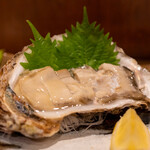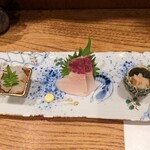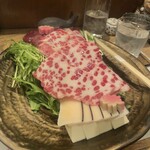
どおぞの
Dozono
3.81
Osaka Station, Umeda, Shinchi
「Whale Dishes」
10,000-14,999円
--
Opening hours: [Monday-Saturday]17:30-23:00 (LO 22:30)
Rest time: Sundays & Holidays
大阪府大阪市北区曽根崎新地1-5-6 新地VIPビル 1F
Photos
(20)




















Details
Reservation Info
can be reserved
Children
child-friendly
Payment Method
Credit cards accepted
(VISA, Master, JCB, AMEX, Diners)
Electronic money is not accepted.
Number of Seats
19 seats
Private Dining Rooms
Yes
(Can accommodate 4, 6, or 8 persons)
Private rooms with sunken kotatsu (for 3 to 10 persons)
Smoking and Non-Smoking
All seats are non-smoking. Smoking is prohibited from April.
Parking
None
Coin-operated parking available nearby
Facilities
Calm space, counter seating, tatami room, sunken kotatsu
Drink
Sake, shochu, wine, and cocktails available
Dishes
Focus on fish dishes
Comments
(20)
MJまつじゅん
4.70
Once you try it, you'll want to eat it again! Not just whale, everything is delicious and you can't go wrong with anything you order! The owner and staff are always smiling and provide pleasant customer service. I always end up drinking too much. It's almost hotpot season now. I will definitely visit again.




。うえ
4.30
I have visited this restaurant several times before, but I haven't been able to post a review yet. Today was my second visit, and I had whale sashimi, fish sashimi, whale bacon, steamed dish, and conger eel. I was a bit drunk and forgot to take photos, sorry. The menu reflected the changing seasons, with summer dishes coming to an end and autumn dishes starting. I enjoyed it with my favorite sake, Eikun. Whether it's the first or second visit, this restaurant always satisfies me. Thank you for the delicious meal. I will definitely come back again!

トモモもも
3.60
Whale cuisine is a part of Japanese culture. I haven't had the opportunity to eat it much, so it was a fresh experience for me. There are various dishes available, from sashimi to hot pot, both as course meals and a la carte options. The corn tempura was especially delicious. The whale hot pot is also known as "Harihari Nabe." The meat has a rich and strong flavor, making it very tasty. We sat in a large group at the back in sunken kotatsu seating. There are also counter seats and regular tables available. It seems like a great place for those who want to try a variety of dishes or enjoy a lively atmosphere with friends.




まぁちゃん35984
3.50
It was a long time since my last visit. The two-person table was small with limited space for bags and hanging coats. I ordered the chef's choice A course. I really enjoy the assorted appetizer plate they serve here. The staff prepares the hot pot for you at the beginning. For the finale, you can choose between thin udon noodles or zosui (rice porridge).




niko-280
4.00
On a certain day in February 2023, I had a whale full course meal at Dozo in Kitashinchi. It was my first time dining at Dozo and trying a whale cuisine full course. I found the location in Kitashinchi and the whale dishes to be reasonably priced. #whalecuisine #Kitashinchi




Yorkchan
2.50
When I tried whale meat for the first time, I found the taste too strong and it didn't suit my palate, but I still want to try it at least once in my lifetime. The taste of whale meat can vary depending on the part of the whale. It's safe to say that it doesn't match the taste buds of Hong Kong people.




やっぱりモツが好き
3.80
I came from Tokyo to Osaka Prefecture. The owner of the restaurant, who is highly regarded in the "whale cuisine" genre and ranked 1st nationwide on Tabelog with a rating of 3.83, learned from Mr. Imagawa Yoshio of Higobashi Murasaki (3.43). After evolving the Murasaki specialty whale shabu-shabu pot, the owner, Mr. Doyuzono, started his own business in 2002. Located in Kita-Shinchi, the restaurant offers a variety of whale dishes such as whale, conger eel, eel, crab, soft-shelled turtle, and blowfish in addition to whale cuisine, positioning itself as a "kaiseki where you can enjoy whale dishes." The course menu is generally accepted for two people, but the whale course can be reserved for one person. I decided to reserve the whale full course (8,500 yen) for one person. I had drinks and food, and the total payment was 22,200 yen. The first dish, the conger eel (appetizer), was of high quality. The umami of the broth and the aroma of sansho pepper brought out the delicate flavor of the conger eel. It showed more sense than the conger eel and new onion soup I had at Kimo-to (4.47), a second brand that cost over 40,000 yen. This is proof that the restaurant has skills as a kaiseki restaurant. The standout item in the first course, the exotic platter, was the bacon of the conger eel. The resilient conger eel released a gradual umami flavor with each bite, reaching a deliciousness of 4.0 grade. This might be the best whale bacon I have ever eaten. The fact that this restaurant is ranked 1st in the whale cuisine genre on Tabelog is no coincidence. According to the owner, Mr. Doyuzono, the whales used are Nitari, Iwashi, and Mink whales, all of which are domestic. They do not handle Nagasu whales, which are only available from Iceland. In the world of whale, it is not necessarily the case that domestic whales are superior to Icelandic whales. I have heard that the Icelandic Iwashi whale, Oma tuna, and other branded ingredients that cost over 20,000 yen were more expensive than the domestic ones purchased by high-end sushi restaurants. In Kamakura, at Kitajima (4.00), which focuses on the Sagami Bay terroir, they sourced local Mink whales from Mr. Daiki Hasegawa of Nagai Fishing Port, a master of nerve-shocked fish. The fatty part of the Mink whale (the fatty part of the conger eel) is the most fresh and easy to eat that I have ever tasted, and it may be the case that local advantages are superior to research whaling. I upgraded the sashimi platter to a five-item platter for an additional 1,200 yen. Except for the red meat, which I found to be lacking in flavor, the other items were of 4.0 grade (the skin was slightly inferior compared to others). In a state of Louis Vuitton, the highest grade part of the whale, the tail meat, melted in the mouth with its elegant fat, while the tongue had a crunchy texture and a stronger umami flavor than the tail meat. Since the red meat was not up to par, the fried whale, steak, and the additional yukhoe I ordered ended up dragging down the restaurant's overall rating. However, specialties ===========




まんおじ
4.50
I have visited this place many times. It's my favorite restaurant. Even my companion who said they don't like the smell of whale meat finished their meal. They made a reservation for the next visit before leaving. I really love the broth here. It goes well with the noodles. The a la carte menu is also recommended.




にじいろさん
3.80
Visit date: 17:30 on a weekday
Wait time: Reservation
Menu: Whale Full Course 9,350 yen
I visited the restaurant at 17:30 on a weekday and ordered the Whale Full Course. It was my first time trying whale meat, and I was pleasantly surprised that it didn't have a strong taste. The sashimi was delicious, and the steak had a nice meaty texture. I originally wanted to try the Harihari hot pot, but all the other dishes were also very tasty. The prices were not too high, so I would like to come back occasionally. Thank you for the wonderful meal.




5ba03676967
5.00
【Doozono】Kitashinchi is a restaurant that offers whale cuisine, which is a part of Japan's food culture. They provide various Japanese dishes such as whale, softshell turtle, blowfish course meals, and fresh fish! I tried the Whale Sashimi 5 types platter! (Enjoy with ginger and soy sauce) - Whale tongue, red meat, deer's child, whale skin, tail meat. Whale sashimi that can only be tasted at a place like this! Some parts are fatty, while others have a bit of elasticity and texture, making it enjoyable! It's delicious!! I also had the seasonal firefly squid!! The sashimi was as beautiful as shown in the photos. I also tried other dishes, grilled fish, and shabu-shabu! 【Doozono】is a luxurious and wonderful place! The restaurant was clean and I could enjoy my meal in a calm atmosphere! I visit various places in Osaka and Kobe to eat! I post about the characteristics, taste, atmosphere of each restaurant, and customer service that I like and want to share with everyone! I would be happy if you could visit the restaurant based on this review!!




チラシックス
0.00
On February 26, 2022 (Saturday) around 5:30 pm, I enjoyed various dishes and drinks. As a person from the Showa era, I have a nostalgic feeling for whales. I remember having whale as a side dish in elementary school lunches, that sweet and savory grilled meat-like dish... I really liked it. So, after a long time without seeing it, I decided to try whale dishes here. The refined whale dishes were excellent. Whale shabu-shabu hot pot. It was really good. Whale is so delicious. I love it. It was delicious. Thank you for the meal.




まんおじ
4.50
This time, I had a casual izakaya experience. It's a famous whale restaurant, but their other dishes are also excellent. Especially their fish dishes are as good as those from specialty shops. I've been a customer for almost 20 years. The assorted whale sashimi is a must-try menu item.




hroh
3.70
We used this place for a banquet at this time. The guest of honor insisted on having whale, so we went for a whale-themed menu. I rediscovered that a whale feast can be quite enjoyable. The right amount of fat and a light aftertaste offer a different kind of goodness compared to beef. Thank you for the meal.




kenta-crv
3.70
Today's visit was to Dozo no. Dozo no is a whale specialty restaurant located in Kita-Shinchi, Kita-ku, Osaka City, Osaka Prefecture. At Dozo no, you can enjoy dishes made with whale, a traditional Japanese cuisine. There are few whale specialty restaurants that offer dishes at an average price close to 10,000 yen, and Dozo no may be the only one in Japan. Intrigued by this, I decided to visit the restaurant that had caught my attention for a while. Dozo no was established in 2002, and after many trials and errors to create whale dishes, they finally developed their trademark "Harishabu Nabe." Armed with this unique dish, they opened in the competitive area of Kita-Shinchi. Personally, I'm not a big fan of hot pot dishes, so this time I ordered the following a la carte items: Mozuku whale sashimi platter, Deer fetus. The sashimi platter had a variety of textures and flavors, with the whale meat melting in the mouth, the Tantan being light and delicate, the skin being chewy and light, and the red meat being tender and flavorful. For more detailed reviews, search 'eatery japan'.




カフェモカ男
3.70
I visited "Doozono" in Osaka, which offers whale dishes, softshell turtle, blowfish, and other Japanese cuisine. They serve high-quality Minke, Iwashi, and Nitari whale meat obtained through research whaling, avoiding imported products. The restaurant is conveniently located just a 1-minute walk from JR Kitashinchi Station, with easy access from Osaka Station, Nishi-Umeda Station, and Umeda Station on various subway lines. The restaurant is located on the 1st floor of the Shinchi VIP Building, tucked away from the main street. The interior features a counter made from a single piece of wood and table seating, creating a relaxing atmosphere. Today, I tried the following menu items: Whale sashimi platter (served with ginger and soy sauce) - Red meat, Saezuri (whale tongue), Tail meat, Jaw meat, and Whale skin slices. Whale hot pot with three types of whale meat: Jaw meat, skin, and red meat. The skin is simmered, while the jaw meat and red meat are enjoyed as shabu-shabu. The whale porridge contains Saezuri, egg, green onion, and seaweed. It was a delightful experience trying various parts of whale meat. Thank you for the meal.




まんおじ
4.10
The price includes the champagne fee. This is the highest-rated restaurant in the early days of Tabelog in Kitashinchi. A platter of four types of whale meat: lean, red meat, skin, and fawn kamasu salt-grilled. Firefly squid shabu-shabu. For the finishing touch, there's egg and udon. Once you try the whale broth here, you'll be hooked.




hiroきち
3.60
Today, I tried the firefly squid shabu-shabu, whale sashimi platter, and bear hot pot recommended by the customer. The firefly squid is from Toyama. I heard there is another kind from Hamasaka, but the one I had was surprisingly delicious with a nice texture. The bear meat was very oily and incredibly delicious. Everything was really delicious.

りえちゃん0099
4.00
"I have visited 'Shin Dozono' several times, but this is my first time at 'Dozono'! I'm looking forward to it ♡ When it comes to Dozono, 'whale' is the main dish, but this time I reserved the 'softshell turtle course' and visited. The first dish is simmered oysters...they are big and plump, with a gentle sweetness that is just right. Softshell turtle hormone simmer...my first time trying this and it's delicious! Various parts are simmered in a sweet and savory sauce, which pairs well with the sansho pepper. It makes you crave chilled sake ♡ Fried chicken...you bite into it with your hands (*⁰▿⁰*) It's so tender that your lips might stick together. The vinegar dish with softshell turtle entrails...it's refreshing and nice♪ The main dish of round hot pot...the broth here is light and delicious ♡ Everything is so delicious without any fishy taste. The soft entrails that melt in your mouth are full of collagen ❤️ The porridge soaked in this broth was also delicious. Softshell turtle raw blood mixed with Japanese sake...I drank it all at once like medicine (๑˃̵ᴗ˂̵)♪ I enjoyed it so much that I asked for a refill...σ(^_^;) Very satisfied ♡ I'm looking forward to my skin condition improving ♪ Next time, I want to try the whale's crunchy hot pot (๑>◡<๑)"




まんおじ
4.10
As usual, I chose Course A. The small dishes each feature seasonal ingredients. The venison, konne, and lean red meat sashimi are all delicious. There is no gamey taste at all. I particularly love the sweet and clear broth here. The noodles served as the finishing touch for the hot pot are also perfectly firm.




rubuna49841
4.00
I visited this restaurant during my trip to Osaka. It was my first time visiting a whale cuisine specialty restaurant. I had a course meal and was surprised to learn that the cooking method can completely change the taste of whale meat. The sashimi was very fresh, and I was able to enjoy various parts of the whale. Each dish brought out the natural flavors of the ingredients and was beautifully delicious. The timing of the dishes and the friendly service from the staff made me feel great, especially when paired with delicious sake. Such restaurants are rare, and the quality and taste of the whale meat are undeniable, so I believe it's worth a visit.




Email Login